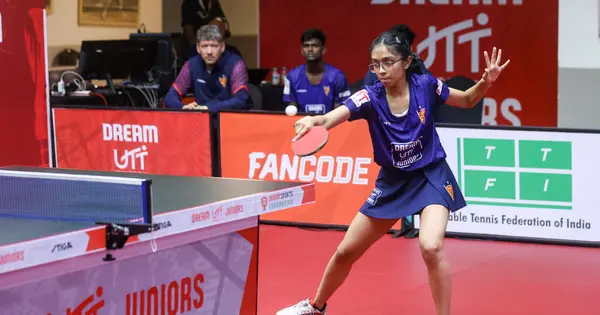Technology
How Fan Engagement Is Evolving with Tech
In Japan, sports have long been tied to ritual, community, and tradition—from sumo stables to packed J.League stadiums. Today’s fans expect much more than just attending a match. They demand participation, interaction, access, backend glimpses, and real-time insights into the event. Digitalization of the sports industry is changing the traditional ways of defining fan engagement. […]


In Japan, sports have long been tied to ritual, community, and tradition—from sumo stables to packed J.League stadiums. Today’s fans expect much more than just attending a match. They demand participation, interaction, access, backend glimpses, and real-time insights into the event. Digitalization of the sports industry is changing the traditional ways of defining fan engagement.
Due to technology, not only the broadcasting of games, but also how players, teams, and even other spectators interact, is experiencing a shift. The smartphone, social media, and even the internet have turned into hubs of spending spare time, and the sports industry is investing in immersive apps that take the audience as close to the action as possible.
Interactive Viewing and Second-Screen Experiences
The rise of second-screen culture—where fans engage with content on phones or tablets while watching a game—has dramatically reshaped live sports. Broadcasters and clubs are now enhancing match feeds with live stats, polls, and fan chats. This multilayered experience is designed to deepen emotional connection while extending the time fans spend interacting with their brand. Innovations related to sports betting online, integrated into match-day dashboards, often mirror the same real-time responsiveness expected by modern viewers.
Japan has begun integrating fan voting during live contests, augmented reality replays, and changing commentary audio streams for companion apps within its professional baseball and soccer leagues. For example, NHK and DAZN Japan offer multi-angle viewing and a strategy breakdown offering. Transforming from a passive observer to an active participant is most remarkable in the case of sports technology.
Key Technologies Driving Engagement
As platforms and franchises strive to maintain engagement amidst growing competition, they are adopting new technology. Perpetual engagement and fandom retention are not, and never have been, new concepts. Remember that as we go over the list.
Important developing technologies altering fan interaction:
- Augmented Reality (AR): Used in stadiums and mobile apps to display stats or player animations
- Virtual Reality (VR): Allows users to “attend” matches through headsets from the comfort of their home.
- NFTs and Digital Collectibles: Grant fans one-of-a-kind assets that are bonded to their favorite teams
- Gamification: Encourages sustained engagement by embedding trivia, forecasts, and other forms of challenges into apps
- AI-Powered Chatbots: give fans instant messaging updates and tailored information using chat applications
Focusing on Japan’s metropolitan areas, where users depend on mobile devices for information and leisure, these tools are extremely pertinent. The combination of entertainment with gaming, as well as sports, is a reasonable progression.
The Role of Social Platforms and User-Generated Content
On TikTok and X (previously Twitter), the content created by ‘normal’ users is being compared to gameday highlights, reactions, and analyses provided by official accounts as they draw similar amounts of attention. In response to this, Japanese teams have changed their policy to simple creation response via a branded hashtag, retweets, and even contests for branded viral content.
Notable esports leagues based in Tokyo offer regular fan shoutouts and also allow active followers to vote on various aspects of the games like team kits and some rules of engagement. These forms of participation, however minimal, support a never-ending exchange between the fans and the organizers. This phenomenon has shifted to be essential to modern fan loyalty.
The effect of gamified design is more noticeable because of online casino slots. Trivia games with ‘spin to win’ mechanics or locked content are commonplace within mobile apps, gaining popularity among beginners which keeps them engaged long after the game is over. These systems encourage a seamless and addictive pattern idealized for daily competition among friends to gain the upper hand, similar to mobile games.
Case Study: J.League’s Fan-Centric Innovations
The J.League has led in connecting with fans digitally across Asia. In 2023 it joined forces with Yahoo Japan and Rakuten to implement a new system where fans can choose “Player of the Match” in real-time during the matches. Votes affect social media activity, discounts on merchandise, and several other engagements including meet-and-greets.
In a separate pilot program, fans wearing smartbands were able to receive haptic feedback synced with game events—buzzes and vibrations that mirrored a goal, a red card, or a substitution. The aim was to make fans feel connected to the action even if they weren’t physically in the stadium.
This model aligns with Japan’s larger smart city ambitions, where personalized digital experiences are integrated across services, from sports to public transit.

Fan Data and Personalized Experiences
All of the novel forms of engagement are collecting unprecedented volumes of information regarding fan behaviors. Currently, AI systems are evaluating this information to generate custom content proposals, bespoke merchandise recommendations, or adjust application features to the user’s behavioral routines. In Japan, where the culture emphasizes meticulousness, data-driven engagement is fostered and deeply effective.
Used by teams in Tokyo, SmartVenue and FanWise possess agile analytic features that segment fans into various activity levels, purchase history brackets, and content preferences. Teams can then deliver targeted notifications, such as birthday discounts, favorite player stats, or live alerts for local games.
As a result, each individual feels appreciated. Now it’s not about the largest crowd, but the most active crowd. It’s not about having the biggest crowd anymore—it’s about having the most engaged one.
Table: Evolution of Fan Engagement Technology
| Era | Key Tools & Methods | Fan Experience Impact |
| Pre-2010 | Traditional broadcast, physical merch | Passive viewing, limited feedback |
| 2010–2020 | Mobile apps, social media | Multi-screen interaction, online communities |
| 2020–Present | AR/VR, AI, NFTs, smart wearables | Real-time feedback, personalized engagement |
What’s Next for Japanese Sports Fans?
The growth of esports in Japan, along with its participation in international tournaments, signals a tech-enabled evolution in fan engagement. Once complete, 5G networks and AI technologies will deliver even more features to fans, including real-time immersion and interactivity.
In-stadium facial recognition systems could streamline access and concessions, while virtual commentators may adjust their style at home based on identified fan preferences. This is not science fiction; it is in progress through joint ventures between Japan’s sports federations and private innovators.
Shifts in culture are also changing the way sports and entertainment are consumed. Fans will engage with the brand far less through the game, but rather through their lives Woven with the digital matrix of existence.
Technology
Key Trends, Market Share, Growth Drivers, And Forecast For 2025-2034
Sports Global Market Report 2025 The Business Research Company’s Sports Global Market Report 2025 – Market Size, Trends, And Global Forecast 2025-2034 The Business Research Company’s Latest Report Explores Market Driver, Trends, Regional Insights – Market Sizing & Forecasts Through 2034” — The Business Research Company LONDON, GREATER LONDON, UNITED KINGDOM, June 23, 2025 /EINPresswire.com/ […]


Sports Global Market Report 2025
The Business Research Company’s Sports Global Market Report 2025 – Market Size, Trends, And Global Forecast 2025-2034
— The Business Research Company
LONDON, GREATER LONDON, UNITED KINGDOM, June 23, 2025 /EINPresswire.com/ — The sports market report describes and explains the sports market and covers 2019-2024, termed the historic period, and 2024-2029, 2034F termed the forecast period. The report evaluates the market across each region and for the major economies within each region.
The global sports market reached a value of nearly $515.47178 billion in 2024, having grown at a compound annual growth rate (CAGR) of 3.08% since 2019. The market is expected to grow from $515.47178 billion in 2024 to $680.79985 billion in 2029 at a rate of 5.72%. The market is then expected to grow at a CAGR of 5.59% from 2029 and reach $893.77119 billion in 2034.
What strategies are being adopted by key players in the sports market?
The key players in the market are adopting extensive strategies in the sports market such as:
Focus on fan engagement through digital channels.
strategic sponsorships to boost visibility.
performance tech for athlete development.
Get The Complete Scope Of The Report
https://www.thebusinessresearchcompany.com/report/sports-global-market-report
To take advantage of opportunities, The Business Research Company suggests that sports companies enhance offerings:
Strategic partnerships to enhance offerings and reach.
Development of next-gen performance trackers for athletes.
AI-powered assistants to improve training and fan interaction.
Strategic investments to expand market presence.
Use of digital analytics to personalize fan engagement.
Adoption of AI, ML, AR & VR to boost experience and performance.
Mobile ticketing solutions for seamless ticket purchases.
What Is Sports Market Overview?
The sports market refers to the ecosystem of activities, services and products related to organized physical competition and recreational athletic engagement. This market includes both professional and amateur sports and spans a wide range of organized competitions, leagues, teams, clubs and events.
Sports are sold through several mechanisms such as ticket sales for live attendance, subscription fees for access to sports networks or streaming services, merchandising of team and event-branded goods and corporate sponsorships. Events and organizations are supported through a network of logistics providers, coaching and medical personnel, media production teams, marketing professionals and infrastructure maintenance services.
Ready to Dive into Something Exciting? Get Your Free Exclusive Sample of Our Research Report
https://www.thebusinessresearchcompany.com/sample_request?id=3589&type=smp
Who Are The Major Companies Operating In The Global Sports Market?
The top ten competitors in the market made up to 2.83% of the total market in 2023. Liberty Media Corporation was the largest competitor with a 0.66% share of the market, followed by:
Life Time Group Hldgs
Topgolf Callaway Brands Corp
Maruhan
Real Madrid C.F
Dallas Cowboys
Manchester City FC
Futbol Club Barcelona
Golden State Warriors
Los Angeles Rams
We Offer Customized Report, Click Here
https://www.thebusinessresearchcompany.com/Customise?id=3589&type=smp
Learn More About The Business Research Company
The Business Research Company (www.thebusinessresearchcompany.com) is a leading market intelligence firm renowned for its expertise in company, market, and consumer research. We have published over 15,000 reports across 27 industries and 60+ geographies. Our research is powered by 1,500,000 datasets, extensive secondary research, and exclusive insights from interviews with industry leaders.
We provide continuous and custom research services, offering a range of specialized packages tailored to your needs, including Market Entry Research Package, Competitor Tracking Package, Supplier & Distributor Package and much more.
Contact Us:
The Business Research Company
Europe: +44 207 1930 708
Asia: +91 88972 63534
Americas: +1 315 623 0293
Email: info@tbrc.info
Follow Us On:
LinkedIn: https://in.linkedin.com/company/the-business-research-company
Twitter: https://twitter.com/tbrc_info
YouTube: https://www.youtube.com/channel/UC24_fI0rV8cR5DxlCpgmyFQ
Oliver Guirdham
The Business Research Company
+44 20 7193 0708
info@tbrc.info
Visit us on social media:
LinkedIn
Facebook
X
Legal Disclaimer:
EIN Presswire provides this news content “as is” without warranty of any kind. We do not accept any responsibility or liability
for the accuracy, content, images, videos, licenses, completeness, legality, or reliability of the information contained in this
article. If you have any complaints or copyright issues related to this article, kindly contact the author above.
![]()
Technology
Ativion and NASEF team up on secure K–12 esports access
Ativion has signed a partnership agreement with the Network of Academic and Scholastic Esports Federations (NASEF) to improve access to scholastic esports in K–12 schools. The collaboration will focus on technical integration and training programs designed to help schools join esports leagues while maintaining secure digital environments. The initiative centers on Ativion’s StudentKeeper platform, which […]

Ativion has signed a partnership agreement with the Network of Academic and Scholastic Esports Federations (NASEF) to improve access to scholastic esports in K–12 schools. The collaboration will focus on technical integration and training programs designed to help schools join esports leagues while maintaining secure digital environments.
The initiative centers on Ativion’s StudentKeeper platform, which combines content filtering, classroom management, and digital safety tools. Through the agreement, NASEF will support Ativion in enhancing StudentKeeper to better serve schools managing esports participation on existing networks and devices.
Simplifying secure access to games
Ativion, formerly known as Impero Solutions, provides cybersecurity, remote access, and EdTech tools used in more than 700 U.S. school districts. Its flagship platform, StudentKeeper, is built on ContentKeeper technology and is currently deployed to protect over 10 million students worldwide.
The partnership is intended to help school IT teams streamline access to gaming environments that support learning outcomes, without compromising student privacy or network integrity.
“We are pleased to join with NASEF to make it easier and safer for schools and leagues to offer scholastic esports programs,” says Tobias Hartmann, CEO of Ativion. “Scholastic esports is an all-inclusive sports program available to every student, and it offers many benefits, academically and socially. We look forward to working closely with NASEF to make StudentKeeper a conduit for schools to grow their scholastic esports programs.”
Supporting school esports growth through StudentKeeper
NASEF is a nonprofit that supports global academic esports programs and provides educators with frameworks for integrating competitive gaming into school activities. The organization operates under the Worldwide Scholastic Esports Foundation and works with over 130 international federations.
The new partnership includes co-led promotional efforts and educator training, with a focus on expanding awareness of esports as a learning and engagement tool.
“School leaders and educators are eager to adopt scholastic esports because of its proven positive impacts on student attendance, grades, test scores, and morale. Of course, it is important that they can access key gaming and information sites without compromising the security of the network. NASEF and Ativion are working together to make that safe access a simpler process,” says Claire LaBeaux, Chief Advancement Officer for NASEF.
Technology
DevLand AI launches EdTech platform to support teachers and students with modernized learning — EdTech Innovation Hub
Devland Academy aims to replace “outdated EdTech” with an AI-powered, gamified platform which it says will increase engagement and teach real-world skills such as AI, robotics and finance. “We’re seeing record-level spending in education, but it’s not making it to the classroom,” explains Michael Kessler, CEO at DevLand AI. “We’re not facing a funding problem […]

Devland Academy aims to replace “outdated EdTech” with an AI-powered, gamified platform which it says will increase engagement and teach real-world skills such as AI, robotics and finance.
“We’re seeing record-level spending in education, but it’s not making it to the classroom,” explains Michael Kessler, CEO at DevLand AI. “We’re not facing a funding problem – we’re facing a priorities problem.”
DevLand AI says the new system aims to “enhance teacher agency, not replace it” as it offers lesson-building co-pilots and smart student tracking. It says the system is in full alignment with the Department of Education’s “human-in-the-loop AI systems”.
“We’re giving teachers the power, the tools, and the platform. It’s time to put the soul back in the classroom,” Kessler adds.
DevLand Academy is already available in pilot markets with plans to expand into charter and public school districts in 2025. The company also plans to launch a paid education contributor program and after-school and homeschool partnerships.
“We welcome partnerships, but we’re not waiting for permission,” Kessler says. “We’re already doing what legislators have struggled to do – empower teachers and engage students.”
Technology
The Inside Scoop for Club World Cup 25’ and World Cup 26’ Newest Tech with FIFA’s Johannes Holzmüller
The FIFA Club World Cup 2025 kicked off here in the United States beginning June 14 and runs through July 13. Our own FOX Sports Radio host, reporter and producer Kelsey Nicole Nelson sat down with FIFA’s Director of Innovation Johannes Holzmüller to break down the debut of the technological advances FIFA is using to […]

The FIFA Club World Cup 2025 kicked off here in the United States beginning June 14 and runs through July 13. Our own FOX Sports Radio host, reporter and producer Kelsey Nicole Nelson sat down with FIFA’s Director of Innovation Johannes Holzmüller to break down the debut of the technological advances FIFA is using to take the Club World and World Cup to new heights.
Holzmüller, who’s been with FIFA since 2008 and typically works out of Switzerland, was on the ground in Miami, Florida to lead the technological transformation of international soccer. In his role as Director of Innovation, he oversees the entire innovation pipeline — from identifying football stakeholders’ needs to developing and implementing new game-enhancing technologies.
Among the biggest innovations for FIFA Club World Cup 2025 is the use of referee body cameras, a first for the tournament and potential next step of first-person visuals in competitive sports. Holzmüller shared that these cameras will allow fans to “see the game through the eyes of an official,” offering a new level of engagement. Notably, the footage will be shared with the tournament’s exclusive global broadcaster DAZN, and even stadium fans will be able to view the referees’ perspectives live on the jumbotrons.
“This will be amazing to see live,” said Holzmüller. “All the spectators have the same information as the referee. It will really be awesome.”
The conversation shifted to another groundbreaking area — artificial intelligence and real-time player tracking. This year, each stadium will house 16 optimal-tracking cameras, capturing 30 data points per player, 50 times per second.
Additionally, game balls are now equipped with IMU sensors, providing precise data on ball movement.
All this feeds into FIFA’s recent partnership with Hawker Innovations, enabling the automatic generation of key match statistics — like passes completed and ball possession—through AI algorithms. “Everything which was collected manually can now be done automatically,” Holzmüller noted.
The FIFA Club World Cup 2025 is serving as a real-time test lab for these tools, all in preparation for even more expansive implementation at the FIFA World Cup 2026.
Coordinating the tournament across 12 stadiums in the U.S. is no small feat. Holzmüller explained that his team has stationed one innovation expert in each stadium, all feeding into a central operations hub at MetLife Stadium in New Jersey.
“It looks a little bit like a Formula One box,” he said. “People sitting in front of monitors, checking and monitoring all the data. We are watching everything that could impact the game.”
Holzmüller made it clear during a conversation on the use of advanced technology and AI that. the goal of innovation isn’t to replace humans but to support them. He cited the infamous 2010 World Cup incident involving Frank Lampard’s disallowed goal as the catalyst that sparked FIFA’s journey into tech-enhanced officiating.
“We’re not saying we want to replace anyone. We just want to support the referees,” he said.
That philosophy is evident in the rollout of semi-automated offside technology, which uses real-time player and ball data to send alerts to assistant referees within milliseconds.
Compared to other countries, Holzmüller said the U.S. stands out for its already tech-rich stadiums. This presented both advantages and challenges, like finding space to install FIFA’s own cameras among the existing infrastructure. But he welcomed the challenge, calling it an “exciting opportunity” to integrate FIFA’s systems with top-tier American technology.
Finally, Holzmüller emphasized that the innovations deployed in theFIFA Club World Cup 2025 will serve as the blueprint for the FIFA World Cup 2026 and even the 2027 FIFA Women’s World Cup.
“All the learnings and feedback, of course, we then bring to the next tournaments where we try to improve,” he said.
From AI-generated data to referee POV cameras and centralized tech hubs, FIFA is embracing a bold new era. And if Holzmüller has his way, the 2025 Club World Cup won’t just crown the world’s best club — it’ll define the future of football itself.
Technology
How corporates are building India’s sports future
India’s ambition to host the 2036 Olympics is more than a national aspiration—it’s a test of how deeply the country is willing to invest in its sporting foundation. Beyond the stadiums and scoreboards, a quiet but powerful shift is taking place. Corporate India, once a passive donor in the sporting world, is now emerging as […]

India’s ambition to host the 2036 Olympics is more than a national aspiration—it’s a test of how deeply the country is willing to invest in its sporting foundation. Beyond the stadiums and scoreboards, a quiet but powerful shift is taking place. Corporate India, once a passive donor in the sporting world, is now emerging as an active partner, building the country’s future in sports from the ground up. Neel Shah, CEO of Dream Sports Foundation, has witnessed this transformation firsthand. “Corporate involvement in sports has moved from basic philanthropy to a strategic and structured methodology,” he said in an exclusive interview to WION.
“It’s no longer just CSR—companies are now developing athlete-focused programs with long-term vision.”
The change is visible across India’s sporting ecosystem. From organising grassroots competitions to investing in performance tech, private players are helping plug critical gaps left by underfunded federations and overburdened institutions. Take Dream Sports Foundation’s own efforts as an example.
Through the Dream Sports Championships in football and table tennis, they’ve created a pathway for young athletes to transition from grassroots to elite levels, aligned closely with National Sports Federations (NSFs). It’s not a stand-alone effort but part of a larger movement. As Shah puts it, “The key word is alignment. We need backward and forward linkages rather than working in silos.”
In a country where NSFs often focus on elite athletes and international medals, grassroots development tends to be neglected. That’s where corporate partnerships are proving to be game-changers—both in reach and in impact. Companies are bringing professional management, long-term strategy, and even regional focus to build sustainable sports programs that can uncover and nurture local talent.
The impact goes beyond training grounds. Technology, often driven by corporate investments, is now deeply integrated into India’s sporting journey. “There’s a huge gap in athlete data capture and performance tracking,” Shah says. “With the right tech, we can build effective athlete profiling, enable better coaching, and even enhance fan engagement.”
From AI-driven analytics to virtual fan experiences, tech is helping sports not only grow but also monetise. This opens up new revenue models and deepens spectator involvement, something India’s sports culture has historically lacked outside of cricket. None of this happens in isolation. The government’s initiatives—like Khelo India and TOPS—have laid a strong foundation for talent identification and Olympic preparation. But Shah is clear: public-private partnerships will be crucial to scale these programs.
While the government brings infrastructure and institutional know-how, the private sector brings innovation, agility, and professionalism. The recent push to launch leagues across multiple sports signals a shift in mindset—from occasional success stories to building a holistic sports culture.
“We’re at a juncture of alignment,” Shah says. “With government, corporates, and federations working together, we have a real opportunity to change the way sports are seen and supported in India.”
As India inches closer to its Olympic ambitions, the athletes we celebrate tomorrow may owe their rise not just to coaches and federations—but to a silent but powerful force working behind the scenes: corporate India, finally playing for the long game.
Technology
Advanced Wellness in Dubuque Offers New Technology to Tighten Skin, Heal Injuries, and Reduce Incontinence
This post was contributed by a community member. The views expressed here are the author’s own. DUBUQUE, IOWA June 12, 2024 – Advanced Wellness is one of the first health centers in the area to offer leading-edge, noninvasive technology using muscle activation to build muscle, burn fat, help with muscle injury and recovery, and strengthen […]

This post was contributed by a community member. The views expressed here are the author’s own.
DUBUQUE, IOWA June 12, 2024 – Advanced Wellness is one of the first health centers in the area to offer leading-edge, noninvasive technology using muscle activation to build muscle, burn fat, help with muscle injury and recovery, and strengthen the pelvic floor. Known for offering medical expertise with aesthetic finesse, Advanced Wellness provides primary and acute care, as well as weight loss, and cosmetic enhancements.
“We are excited to expand our practice to a new level offering leading-edge, non-invasive medical devices for treating everything from incontinence to musculoskeletal injuries,” says Nicole M. Schlosser, founder of Advanced Wellness and a nurse practitioner who has served the community for years.
Emsculpt NEO, a needle-free and laser-free technology creates muscle contractions and uses radiofrequency to generate heat. That combination burns 30 percent fat and builds 25 percent muscle in hard-to-treat areas, including the abdomen, buttocks, arms, and thighs. The device forces muscles to experience tens of thousands of contractions — equivalent to 20,000 sit-ups in just 30 minutes.
Find out what’s happening in Across Iowafor free with the latest updates from Patch.
“Emsculpt NEO is excellent for those on a weight loss journey and want to tone and tighten flabby skin, and it also has an application for patients who want to address muscle strength and function or are recovering from an injury,” says Schlosser. Emface, another non-invasive technology uses heat and muscle activation to boost collagen production and tighten facial skin. In just 20 to 30 minutes, it revitalizes the face by stimulating underlying tissue, which reduces fine lines.
Another new technology, EMSELLA, is a gamechanger for the more than 25 million Americans struggling with pelvic floor weakness and incontinence. Patients are fully clothed and sit in the EMSELLA chair, which uses electromagnetic energy to strengthen the pelvic floor by inducing muscle contractions. A 30-minute session is equivalent to doing 11,000 Kegel exercises. EMSELLA has a 98-percent patient satisfaction rate and allows patients to enjoy daily activities without losing bladder control.
Find out what’s happening in Across Iowafor free with the latest updates from Patch.
“These procedures are needle-free, pain-free and there is no bruising,” says Schlosser.
“With no downtime needed, patients go back to work and daily activities after each session.”
Advanced Wellness is located at 2442 Meinen Ct, Dubuque, IA 52002. To learn more
about these leading-edge technologies, call Advanced Wellness at 563-556-6292 or log on to
www.advancedwcdbq.com.
The views expressed in this post are the author’s own. Want to post on Patch?

-

 High School Sports3 weeks ago
High School Sports3 weeks agoParents Speak Out As Trans Pitcher Throws Shutout In MN State Quarterfinals
-

 Professional Sports3 weeks ago
Professional Sports3 weeks ago'I asked Anderson privately'… UFC legend retells secret sparring session between Jon Jones …
-

 Health3 weeks ago
Health3 weeks agoOregon track star wages legal battle against trans athlete policy after medal ceremony protest
-

 Professional Sports3 weeks ago
Professional Sports3 weeks agoUFC 316 star storms out of Media Day when asked about bitter feud with Rampage Jackson
-

 Motorsports1 week ago
Motorsports1 week agoNASCAR Weekend Preview: Autódromo Hermanos Rodríguez
-

 College Sports3 weeks ago
College Sports3 weeks agoOKC’s Mark Daigneault knows what it takes to win championships. His wife has won a ton of them
-

 NIL2 weeks ago
NIL2 weeks agoPatrick Mahomes in OKC for WCWS, praises NiJaree Canady and Texas Tech
-

 College Sports3 weeks ago
College Sports3 weeks agoFull 2025 Women’s College World Series Finals Schedule
-

 NIL2 weeks ago
NIL2 weeks agoGreg Sankey fires jab at obstruction rule after controversial WCWS call in Texas vs. Texas Tech
-

 NIL2 weeks ago
NIL2 weeks agoReport































